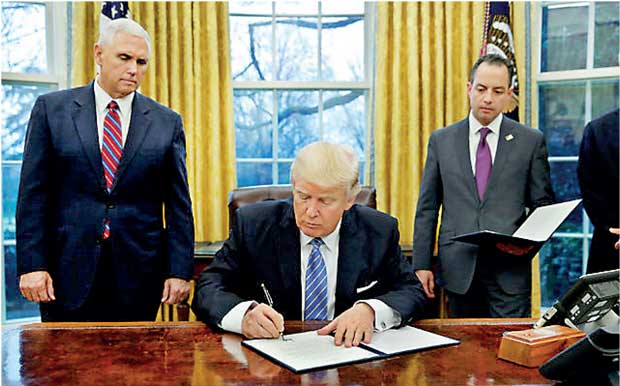25 Jan 2017 - {{hitsCtrl.values.hits}}

By Sourabh Gupta
Placing his palm on the same Bible that President Lincoln used at his inauguration, Donald J. Trump was sworn in amid pomp and protest as the 45th president of the United States on January 20. On the same day, 156 years ago, with the Civil War looming, Lincoln had counselled his countrymen to renew the common ties that bound them. “We are not enemies, but friends … we are not, we must not be aliens or enemies but fellow countrymen and brethren,” he had vainly noted.
President Trump’s message, by contrast, was hardly intended to appeal to the better angels of America’s nature. Yet, as he gets down to the gruelling task at hand, Trump would be wise to apply Lincoln’s appeals to his international allies and partners, notably in the Asia Pacific.
For the better part of 70 years, the United States has, by and large, been a force for good in Asia, deploying its superior strength and resolve in the service of secure sea lanes, open markets and stable politics. Non-reciprocal market access for Asia’s light manufacturing exports was at the core of this strategy. The US Navy’s Seventh Fleet was, secondarily, tasked with protecting the sea lanes that delivered the energy resources that fuelled this manufacturing-driven engine of prosperity in Asia.
But under the weight of Trump’s outsize personality and a set of anti-trade (and anti-immigrant) beliefs, which he shares with his core advisors, the US stands poised to forfeit the patent on the Asian geopolitical ‘operating system’ that it laboriously conceived, constructed and managed over the past seven decades.
Negative connotations for Asia Pacific
Four of seven points that constitute the centrepiece of President’s Trump’s economic plan to protect the United States “from the ravages of other countries making our products [and] stealing our companies” bear direct, negative connotations for the Asia Pacific.
First, the Trans-Pacific Partnership agreement is to be torn down, devaluing in the process the immense political capital expended in the negotiations by the leaders of the Asia Pacific’s richest (Japan and Australia) as well as one of its poorest (Vietnam) economies. A ‘border tax’ that will be applied to all imports, irrespective of origin, will add insult to injury. It may ironically fall upon China to rescue the United States’ trade footprint in Asia by way of its leadership of — and US engagement within — the Free Trade Area of the Asia-Pacific (FTAAP) discussions.
Second, the Asia Pacific’s largest economy (China) is to be labelled a currency manipulator and, in time, presumably hit with countervailing duties. Treating a currency’s value to be an actionable subsidy would be a violation of international trade law. Only enterprise-specific, industry-specific, region-specific or export-contingent subsidies that cause injury in foreign markets are legally challengeable through countervailing action.
Naming China a currency manipulator would also fall afoul of the International Monetary Fund’s (IMF) surveillance-related rules. Even if the People’s Bank of China had not been propping up the yuan’s value, the IMF guidelines require the offending country’s exchange rate to be misaligned for the purpose of securing an increase in net exports. The fact that its policies merely have this effect is insufficient.
Third, Trump’s trade policy team — Wilbur Ross at Commerce Department, Robert Lighthizer at United States Trade Representative and Peter Navarro at National Trade Council — have promised to use every lawful exercise of presidential trade enforcement authority to remedy the supposedly illegal activities that have precipitated the United States’ trade deficits with Asia.
But pressed to identify specific violation/s by China of international trade rules, they are unable to lay out a legally durable case. More problematically, they have hinted that adverse World Trade Organisation (WTO) dispute settlement rulings may not be complied with, given that such rulings amount to instrumental law that is ‘only worthy of compliance to the extent that compliance makes [the American] people better off’.
Parenthetically, 30 years of badgering Japan with what was an even broader toolkit of trade penalties did nothing to reverse the bilateral trade imbalance. Rather, it produced an appreciation in the yen’s value, which in turn inflicted deflation and stagnation on the economy of the United States’ foremost ally in the Asia Pacific.
Finally, Asia’s fastest growing economy — India — is not to be spared either. Information technology-enabled services have in recent times assumed an outsized role in elevating India’s image as a modern and globally competitive society. But in the eyes of Steve Bannon, President Trump’s chief strategist, the disproportionately large representation of South Asians in Silicon Valley represents a cultural assault.
The wheels are in motion to restructure the H1-B work visa programme — emulating the past efforts of incoming attorney-general Jeff Sessions to raid the very programme that has aided the rise of India on the back of its outsourcing prowess and deepened US–India people-to-people ties.
Quoting Charles Dickens in his keynote address at the World Economic Forum annual meeting in Davos, Switzerland, on January 17, 2017, Chinese President Xi Jinping extended a stretched hand to his regional and global counterparts and welcomed them aboard the express train of China’s development. Seventy years earlier Harry Truman had extended a similar handshake, and ride, to Asia. Whether Trump — the greatest come-from-behind victor in the US presidential politics since Truman himself in 1948 — will relinquish his predecessors’ legacy and the United States’ standing and goodwill in Asia remains to be seen.
(East Asia Forum)
(Sourabh Gupta is a senior fellow at the Institute for China-America Studies in
Washington, D.C.)
25 Nov 2024 1 hours ago
25 Nov 2024 2 hours ago
25 Nov 2024 2 hours ago
25 Nov 2024 4 hours ago
25 Nov 2024 4 hours ago